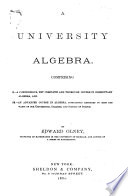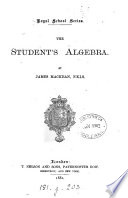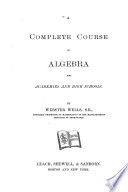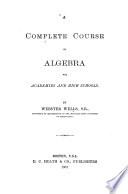 If any number of quantities are proportional, any antecedent is to its consequent as the sum of all the antecedents is to the sum of all the consequents. Let a : b = c : d = e :f Now ab = ab (1) and by Theorem I. If any number of quantities are proportional, any antecedent is to its consequent as the sum of all the antecedents is to the sum of all the consequents. Let a : b = c : d = e :f Now ab = ab (1) and by Theorem I.  An Elementary Geometry - Page 30by William Frothingham Bradbury - 1873 - 110 pagesFull view An Elementary Geometry - Page 30by William Frothingham Bradbury - 1873 - 110 pagesFull view - About this book
 | Edward Olney - Algebra - 1880 - 354 pages
...Ъ—dl У£. СОЕ. — If there be a series of equal ratios in the form of a continued proportion, the sum of all the antecedents is to the sum of all the consequents, as any one antecedent is to its consequent. DEM. — If a : b : : e : d : : e :f: : g : A, etc., a... | |
 | James Mackean - 1881 - 510 pages
...Mixing. PROP. XIV. — When several quantities are in continued proportion, any one of the antecedents is to its consequent as the sum of all the antecedents is to the sum of all the consequents. a ma + ne + pe Theorem IX., l=mb + nd+pf, and if mnp-1, a a+c+e . . then т = f,i _r~?; ... a:o::a... | |
 | Edward Olney - Algebra - 1881 - 504 pages
...,eíc.) : (b + d+f+h + k + ,etc.) ::a:ö,or с : d, or e : f, etc. That is, in a series of equal ratios, the sum of all the antecedents is to the sum of all the consequents, as any antecedent is to its consequent. _ aa -, -, а с , , Solution, v — т or ab = ba, - = ^01... | |
 | Edward Olney - Algebra - 1882 - 358 pages
...:b—d1 72. Сок. — If there be a series of equal ratios in the form of a continued proportion, the sum of all the antecedents is to the sum of all the consequents, as any one antecedent is to its consequent. DEM. — If a : b : : с : d : : e :/: : g : h, etc., a... | |
 | James Bates Thomson - Algebra - 1884 - 334 pages
...T=|. That is, a : b = e : d Again, 12 : 4 = 6 : 2, and 9:3 = 6:3 .-. 12 : 4 = 9 : 3 THEOBEM X. Wlien any number of quantities are proportional, any antecedent...to the sum of all the consequents. Let a : b :: e : d ::«:/, etc. Then a : b :: a + c + e : b + d+f, etc. For (Th. i), ad — be And, " af=be Also,... | |
 | Webster Wells - Algebra - 1885 - 324 pages
..._r^. a — о с — a Whence, a + b: a — b — c + d: c — d. 302. In a series of equal ratios, any antecedent is to its consequent, as the sum of...antecedents is to the sum of all the consequents. Let a: b = c: d = e:f. Then, by Art. 293, ad = be, and o/= be. Also, ab = ba. Adding, a(b + d+f) = b(a+c + e).... | |
 | Webster Wells - Algebra - 1885 - 370 pages
...(2), а±! = *±£ ab c—d Whence, a + b: a — b = c + d: c — d. 302. In a series of equal ratios, any antecedent is to its consequent, as the sum of...antecedents is to the sum of all the consequents. Let a: 6 = c: d = e :/. Then, by Art. 293, ad = be, and af= be. Also, a6 = ba. Adding, a(b + d+f) = b(a+c... | |
 | Webster Wells - 1885 - 368 pages
...(2) Dividing (1) by (2), Whence, a + b: a — b = c + d: c — d. 302. In a series of equal ratios, any antecedent is to its consequent, as the sum of...antecedents is to the sum of all the consequents. Let a:b = c:d = e:f. Then, by Art. 293, ad = bc, and a/= be. Aîso, a6 = ba. Adding, a(b + d+f) = b(a+c... | |
 | Webster Wells - Algebra - 1885 - 382 pages
...= «±А а—о с— a Whence, a-\-b: a — b = c + d: c — d. 302. In a series of equal ratios, any antecedent is to its consequent, as the sum of...antecedents is to the sum of all the consequents. Let a:b = c:d = e:f. Then, by Art. 293, ad = &c, and af= be. Also, a& = ba. Adding, a(b + d+f) = b(a +... | |
 | Webster Wells - Algebra - 1885 - 372 pages
...(2) a Dividing (1) by (2), Whence, a + b: a — b = c + d: c — d. 302. In a series of equal ratios, any antecedent is to its consequent, as the sum of all the antecedents is to the sum oj all the consequents. Let a:b = c:d = e:f. Then, by Art. 293, ad = be, and af=be. AÎSO, ab = ba.... | |
| |